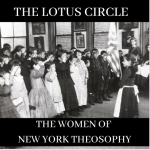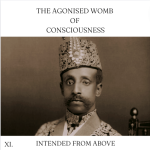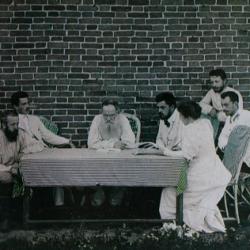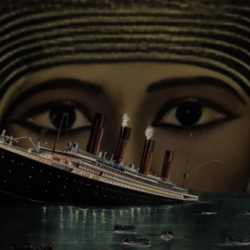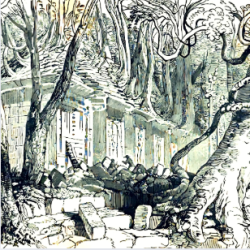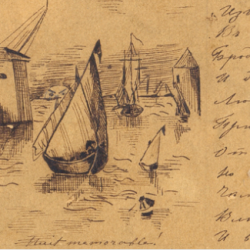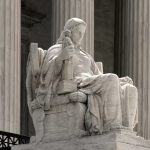THE REINCARNATION OF E.D. WALKER
On April 28, 1890, a telegram was sent to the family of Edward Dwight Walker in Brooklyn. It said that Walker went missing on April 26, but his baggage and effects were still at the Coast Line Hotel in Weldon, North Carolina.[1] Walker’s brother-in-law, Willis Van Valkenburg, “Van” as he was known by friends, arrived in Weldon on May 1, to personally supervise the search.[2] Being a shorthand crime reporter in New York, Van was more than qualified.[3]
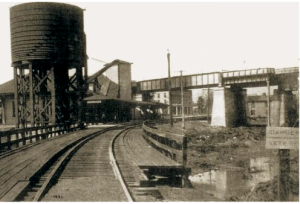
The Atlantic Coast Line Hotel, Weldon, N.C. (c/o Historic Weldon.)
“On the morning of April 26, he told me that he was expecting a note,” said the owner of the Coast Line Hotel. “He said that if it came, that it should be sent to his room.”
“Did any note arrive?”
“No, sir,” said the hotelier. “He waited in his room until 10 a.m., but no one came.”
“He just remained in his room?”
“He went to the river.”
“He told you that he was going to the river?”
“No,” the hotelier replied. “He was seen on the banks around noon by some parties who were on the Roanoke River in boats with fishing nets. They say that he was watching them. Some townsfolk say that he went ‘suddenly insane’ and just wandered off.”
“There is nothing whatsoever to sustain that theory,” Van Valkenburgh. Walker may have had some peculiar theories, Van Valkenburg thought, but he was by no means “insane.”
“It’s true,” said another lodger at the hotel. “Mr. Walker acted rather strangely. He told me that he came here on a fishing trip. I thought it very singular that he had come to such a place to go fishing. When he started out the next morning without the aid of a guide, there was quite a bit of stir. He paid his bill at the front desk and ordered his baggage to be forwarded to Baltimore—which caused much comment. He started away alone, and ain’t been seen since.”[4]
Van was determined to find Walker. Hand bills were distributed around town offering a reward for his discovery, “dead or alive.”[5] A hunting party of one hundred men was then organized, and a thorough search expedition was marked out. The whole section of the country was scoured in the hope of finding the missing man.[6]
~

Edward Dwight Walker.[7]
Born in New Haven, Connecticut, on June 16, 1859, E.D. Walker developed into a sober-minded young bachelor, that was also “something of an artist, and musician.” After graduating from William College in 1876, Walker became an assistant in the editorial-rooms of Harper’s Magazine. His friendly disposition quickly won over “all whom he came in contact,” and it was said that “no one of the younger literary men of New York possessed a wider circle of friends.” Walker became “thoroughly conversant with [the] book, art, and editorial work,” of Harpers, and worked his way up, successively, as the chief assistant in various departments. He eventually became the “right-hand man” of the Harper’s Magazine editor. It was Walker who first introduced the idea of color illustrations in magazine, which he published in the article “Precious Stones in the United States,” for the December 1887, issue of Harper’s Magazine. In addition to editing, Walker contributed prose, verse, and scientific articles, with “welcome admission” to many magazines, encyclopedia, and other publications.[8]
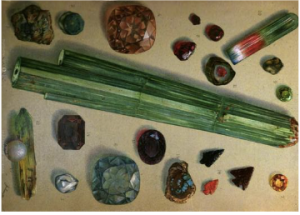
Illustration from the article: “Precious Stones in the United States.”[9]
On February 21, 1886, Walker joined the Theosophical Society.[10] He became a frequent guest of Laura C. Holloway, who hosted Sunday evening discussions on Theosophy in her home at 181 Schermerhorn Street (Brooklyn, New York.)[11] Walker himself lived in his sister Clara’s home (along with her husband, Willis Van Valkenburg,) at 357 Seventh Street. Their widowed mother, Sarah, also lived there.[12] At the same time that Walker joined the Theosophical Society, he left his position at Harper’s to begin work on a new magazine called Cosmopolitan, which hit the newsstands in March 1886.[13]
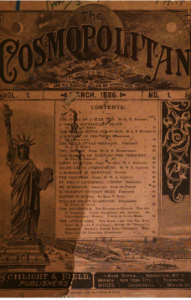
First Issue of Cosmopolitan, March 1886.
In March 1887, a visiting Indian Theosophist named Mohini Chatterji, delivered a talk on Hinduism and Christianity in the home of Laura C. Holloway.[14] “Christianity is at one with the Vedantic sacred canons in teaching that ‘the Kingdom of Heaven is within you,’” Mohini stated.[15] Mohini’s lecture convinced Walker that Christianity and Eastern traditions were harmonious, and that evidence of “transmigration of the soul” could be found in the Christian Bible.
Walker set out to investigate “the doctrine variously termed as ‘Reincarnation,’ ‘Metempsychosis,’ ‘Transmigration.’” He would discuss his research at Theosophical Society meetings, and publish his findings in the American Theosophical journal, The Path, throughout 1887.[16]
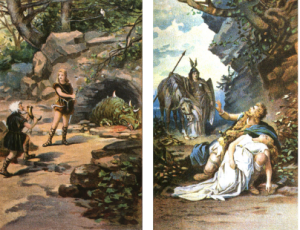
“Siegfried and Mime” & “Brünnhilde Appears to Siegmund and Sieglinda.” First Color Illustrations in Cosmopolitan (March 1888.)[17]
In March 1888, Walker became the new editor of Cosmopolitan.[18] Just as he did with Harper’s, Walker introduced the “feature of color work” to that magazine for the first time.[19] The first illustration was of Siegfried and Mime in a piece about German Opera in New York.[20] Meanwhile, Walker’s research in reincarnation culminated in the book, Reincarnation: A Study of Forgotten Truth (1888.)[21] The work, published by John W. Lovell (who joined the Theosophical Society the same year as Walker) became the earliest text to link Christianity with reincarnationist beliefs.[22] In his preface for Reincarnation, Walker writes:
The present perplexity of all Christendom upon the deepest problems of life, the sense of blind fate oppressing mankind, the despairing restlessness of many leading poets, the absence of sublime ideals in art, the prevalence of materialism and agnosticism (if not in philosophy, in the most vital form of practical life,) all feed a flood-tide of dissatisfaction which Christianity tries in vain to resist and indicate that the West deeply needs some new truth […] A portion of this is contained, we believe, in the doctrine variously termed as ‘Reincarnation,’ ‘Metempsychosis,’ ‘Transmigration.’ By this we do not mean the theories concerning re-birth of men in brute bodies, which are attributed to oriental religions and philosophies because popularly accepted by their followers. These are crude caricatures of the true conception. They represent the reality as absurdly as ordinary life in Europe and America illustrates the teaching of Jesus. But we mean the inner kernel of that husk, which in protean forms has irrepressibly welled up in every great phase of thought, which is an open secret lying all around us and not simply a foreign importation, and which Christendom cannot afford to lose. For those who are content with the usual creeds this little work will have no attraction. They may be pleased to regard it as a heathen invasion of Christendom. But for truth-seekers it may prove useful, though it claims only to be an earnest investigation of what seems an indemonstrable proposition. Its doctrine was first met as the declaration of the profoundest students of the mysteries enveloping humanity coming with authority but no proof of weight to most western thinkers. Its violent antagonism to current ideas compelled the writer to dispose of it by independent methods. If true, there must be some confirmation of it such as will impress any candid mind. If false, nothing can force it to live.[23]
William Quan Judge (prominent American Theosophist, and editor of The Path,) said it was “one of [the Theosophical Society’s] most invaluable works.”[24] Blavatsky (the founder of the Theosophical Society) stated: “Mr. Walker cannot be too heartily congratulated on the manner in which he has written his book. He has arranged his facts in a masterly way and has devoted so much time and study to the subject that he is able to cite in his favor a large majority of those writers and thinkers who have distinguished their race at all the historical epochs of human progress.”[25] The secular press equally praised Walker’s Reincarnation, stating, “…The student of Theosophy and Esoteric Buddhism will find [the work] interesting, and [raise questions] some of which the Christian believer will find difficult to answer—If he cares to answer it.”[26] The work ultimately gave Walker “extended reputation,” and won him membership in both the Authors Club, and Fellowcraft Club.[27]
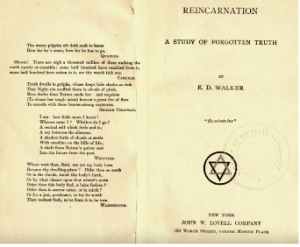
Title Page, E.D. Walker’s Reincarnation (1888.)[28]
Walker was compiling material for a companion piece to Reincarnation tentatively called Karma. His “persistent application” and hard work, however, had finally caught up with him, and his health was undermined. He took a “roving commission” down South with the hope that some country air would do him some good.[29] His first stop was Point of Pines, Arizona, but the sight of so many sick people made him depressed.[30] He then “went among the Southern Pines,” registering at the Coast Line Hotel on April 24, 1890.[31]
~
On the evening of his arrival Van telegraphed the family in Brooklyn: “Edward was found in the river this morning. Will reach home tomorrow morning.”[32]
During the search that day, Walker’s body was found in the Roanoke River with “several cords upon different parts of [the body] hanging lose, as though something had been tied to them.” Walker’s body was brought ashore. After a hurried examination by the coroner and a jury, an inquest was held, which resulted in a verdict of “accidental death.”
~
The voice of the speaker who read the poem “Beyond the Roanoke” at Walker’s funeral on May 2, was smothered by the sobs of anguished hearts. After the service, the mourners slowly filed out of the darkened rooms of Brooklyn’s Greenwood Cemetery, into the bright sunlight. The procession wended the sloping green hillsides, over the swelling knolls, and past gaudily adorned tombs of the cemetery until it reached the quiet spot where the open grave of Edward Dwight Walker awaited them. Walker, as his friend’s noted, took “keenest delight in [nature’s] every mystery and every beauty would have been happy, this bright sunshiny day, to have sauntered amid much that told of the love of the Creator.”[33] The circumstances surrounding his death remain a mystery.
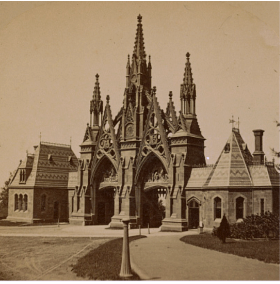
“Entrance to Greenwood Cemetery.”[34]
SOURCES:
[1] “Editor Walker Missing.” The Sun. (New York, New York) April 30, 1890.
[2] “Mr. Walker Still Missing.” The State Chronicle. (Raleigh, North Carolina) May 2, 1890.
[3] “Willis Van Valkenburgh.” The Stenographer and Photographic World. Vol. XLVII, No. 2 (February 1918): 52.
[4] “The Death of E.D. Walker” The Brooklyn Daily Eagle. (Brooklyn, New York) May 2, 1890; [4] “Editor Walker Was Drowned.” The Sun. (New York, New York) May 2, 1890.
[5] “Mr. Walker Still Missing.” The State Chronicle. (Raleigh, North Carolina) May 2, 1890.
[6] “Mr. Walker Still Missing.” The State Chronicle. (Raleigh, North Carolina) May 2, 1890.
[7] J.B.W. “In Memoriam.” The Cosmopolitan. Vol. IX, No. 3. (July 1890): 382-383.
[8] “General Gossip Of Authors And Writers.” Current Literature. Vol. II, No. 2 (February 1889): 102-106; “Editor Walker Missing.” The Sun. (New York, New York) April 30, 1890; “A Magazine Editor’s Untimely Death.” The Bismarck Tribune. (Bismarck, North Dakota) May 23, 1890; J.B.W. “In Memoriam” The Cosmopolitan Vol. IX, No. 3. (July 1890): 382-383.
[9] Kunz, George F. “Precious Stones In The United States.” Harper’s New Monthly Magazine. Vol. LXXVI, No. 251 (December 1887): 97-106.
[10] Theosophical Society General Membership Register, 1875-1942 at http://tsmembers.org/. See book 1, entry 3586. (Website file: 1B:1885-1890) Edward D. Walker. (2/21/1886.)
[11] Thackeray, E.A. “Mrs. Laura Holloway Langford.” The Writer. Vol. V, No., 6. (June 1891): 119-121.
[12] Clara L. Walker/ Sarah Walker/ Edward Walker] Year: 1880; Census Place: Brooklyn, Kings, New York; Roll: 855; Page: 115D; Enumeration District: 225; Clara & Willis Van Valkenburg] Year: 1910; Census Place: East Orange Ward 3, Essex, New Jersey; Roll: T624_883; Page: 19A; Enumeration District: 0167; FHL microfilm: 1374896; “Editor Walker Missing.” The Sun. (New York, New York) April 30, 1890.
[13] “Editor Walker Missing.” The Sun. (New York, New York) April 30, 1890.
[14] “He Was Weary When He Left.” The Brooklyn Daily Eagle. (Brooklyn, New York) March 31, 1887.
[15] “Oriental Theosophy.” The New York Tribune. (New York, New York) November 28, 1886.
[16] “The Poetry of Reincarnation in Western Literature Pt. I.” The Path. Vol. II, No. 4. (July 1887): 102-107; Walker, E.D. “The Poetry of Reincarnation in Western Literature Pt. II.” The Path. Vol. II, No. 5. (August 1887): 133-138; Walker, Edward Dwight. Reincarnation: A Study of Forgotten Truth. John W. Lovell Company. New York, New York. (1888): vii-ix.
[17] Finck, Henry T. “German Opera in New York.” The Cosmopolitan. Vol. V, No. 1. (March 1888): 1-23.
[18] “Periodical Literature.” The American. Vol. XV, No. 398. (March 24, 1888): 369.
[19] “A ‘Cosmopolitan’ Change.” The Evening World. (New York, New York) December 10, 1888; “General Gossip Of Authors And Writers.” Current Literature. Vol. II, No. 2 (February 1889): 102-106; J.B.W. “In Memoriam.” The Cosmopolitan Vol. IX, No. 3. (July 1890): 382-383.
[20] Finck, Henry T. “German Opera in New York.” The Cosmopolitan. Vol. V, No. 1. (March 1888): 1-23.
[21] Walker, Edward Dwight. Reincarnation: A Study of Forgotten Truth. John W. Lovell Company. New York, New York. (1888.).
[22] Theosophical Society General Membership Register, 1875-1942 at http://tsmembers.org/. See book 1, entry 3801. (Website file: 1B:1885-1890) John W. Lovell. (11/30/1886); Hammer, Olav. Claiming Knowledge: Strategies of Epistemology from Theosophy to the New Age. Brill. Leiden, Netherlands. (2021): 470.
[23] Walker, Edward Dwight. Reincarnation: A Study of Forgotten Truth. John W. Lovell Company. New York, New York. (1888): vii-ix.
[24] “Literary Notes.” The Path. Vol. III, No. 1. (April 1888): 23-26.
[25] “Reviews: Reincarnation” Lucifer Vol. II, No. 12 (August 15, 1888): 485-487.
[26] “Reincarnation.” The Detroit Free Press. (Detroit, Michigan) May 13, 1888.
[27] J.B.W. “In Memoriam.” The Cosmopolitan. Vol. IX, No. 3. (July 1890): 382-383.
[28] Walker, Edward Dwight. Reincarnation: A Study of Forgotten Truth. John W. Lovell Company. New York, New York. (1888): Title Page.
[29] “Editor Walker Missing.” The Sun. (New York, New York) April 30, 1890; “Obituary Notice.” The Path. Vol. V, No. 2. (May 1890): 72.
[30] “Is Mr. Walker Drowned?” The Evening World. (New York, New York) April 30, 1890.
[31] “Editor Walker Missing.” The Sun. (New York, New York) April 30, 1890; J.B.W. “In Memoriam.” The Cosmopolitan. Vol. IX, No. 3. (July 1890): 382-383.
[32] “Editor Walker Was Drowned.” The Sun. (New York, New York) May 2, 1890.
[33] J.B.W. “In Memoriam.” The Cosmopolitan. Vol. IX, No. 3. (July 1890): 382-383.
[34] Moulton, John S., Approximately Photographer. Entrance to Greenwood Cemetery. Brooklyn New York a New York, None. [Between 1860 and 1930] Photograph. https://www.loc.gov/item/2017656267/.


